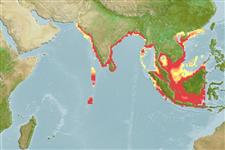Common names from other countries
Classification / Names / Names
Nomi Comuni | Sinonimi | Catalog of Fishes (gen., sp.) | ITIS | CoL | WoRMS
Environment: milieu / climate zone / depth range / distribution range
Ecologia
; salmastro; distribuzione batimetrica 4 - 90 m (Ref. 8). Tropical; 26°N - 9°S, 62°E - 118°E
Indo-West Pacific: from Pakistan to Vietnam and Borneo.
Length at first maturity / Size / Peso / Age
Maturity: Lm ? range ? - ? cm Max length : 15.2 cm TL maschio/sesso non determinato; (Ref. 8); common length : 13.0 cm TL maschio/sesso non determinato; (Ref. 8)
Juveniles are found in mangrove inlets, intertidal and subtidal edge of mud flats, near inshore and far inshore waters (Ref. 121464). Found in seagrass, sand and among shells (Ref. 121467).
Life cycle and mating behavior
Maturità | Riproduzione | Deposizione | Uova | Fecundity | Larve
Members of the order Decapoda are mostly gonochoric. Mating behavior: Precopulatory courtship ritual is common (through olfactory and tactile cues); usually indirect sperm transfer.
Holthuis, L.B. 1980. (Ref. 8)
IUCN Red List Status (Ref. 130435)
CITES status (Ref. 108899)
Not Evaluated
Not Evaluated
Human uses
Pesca: commerciale
| FishSource | Sea Around Us
Strumenti
Fonti Internet
Estimates based on models
Preferred temperature
(Ref.
115969): 26.5 - 29.1, mean 28.3 (based on 1550 cells).
Resilienza
Alto, tempo minimo di raddoppiamento della popolazione meno di 15 mesi (K=0.87-0.93).
Vulnerability
Low vulnerability (15 of 100).
